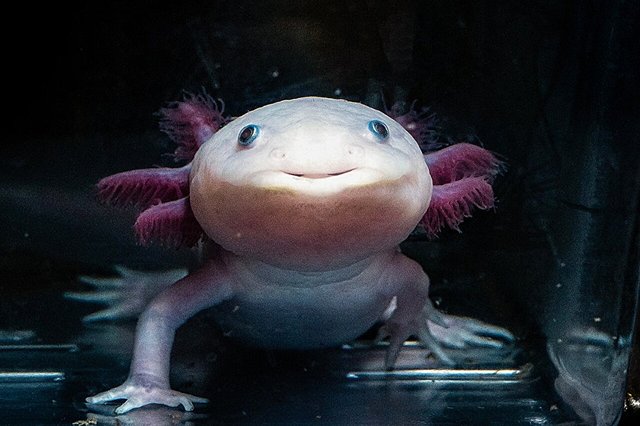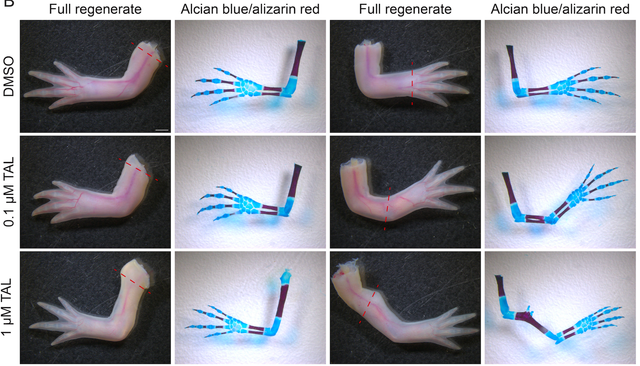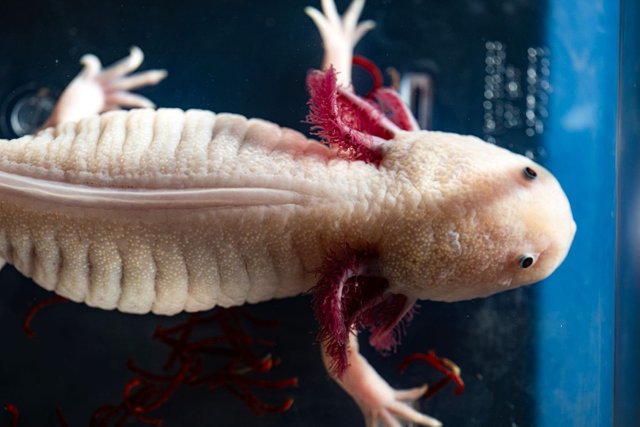They discover how axolotes regenerate their limbs/Descubren cómo los axolotes regeneran sus extremidades

Source
The axolote (Ambystoma Mexicanum), originally from the lakes of Mexico, especially Xochimilco, is a type of salamandra that does not complete its metamorphosis, that is, it lives its whole life in a larval state, even when it becomes sexually mature. It has an elongated body, short legs, a long tail and feathery gills that leave the sides of the head. But what really makes it famous in biology is its ability to regenerate limbs, eyes, and even parts of the heart and brain.
El axolote (ambystoma mexicanum), originario de los lagos de México, especialmente de Xochimilco, es un tipo de salamandra que no completa su metamorfosis, es decir, vive toda su vida en estado larvario, incluso cuando se vuelve sexualmente maduro. Tiene un cuerpo alargado, patas cortas, una cola larga y branquias plumosas que salen de los lados de la cabeza. Pero lo que realmente lo hace famoso en biología es su capacidad para regenerar extremidades, ojos, e incluso partes del corazón y del cerebro.
With this ability you will understand that these animals are subject to all kinds of biological studies to try to understand how this regeneration mechanism works. In a recent study they have identified retinoic acid (a derivative of vitamin A) as a crucial factor in limb regeneration in axolotes. They have discovered that the axolote maintains a retinoic acid gradient along its limbs. Higher levels of retinoic acid are close to the shoulder and decrease as they approach the hand, regulated by an enzyme called CYP26B1.
Con esta habilidad entenderéis que estos animalejos son objeto de todo tipo de estudios biológicos para intentar entender como funciona este mecanismo de regeneración. En un estudio reciente han identificado el ácido retinoico (un derivado de la vitamina A) como un factor crucial en la regeneración de extremidades en los axolotes. Han descubierto que el axolote mantiene un gradiente de ácido retinoico a lo largo de sus extremidades. Niveles más altos de ácido retinoico se encuentran cerca del hombro y disminuyen a medida que se acercan a la mano, regulados por una enzima llamada CYP26B1.

Source
This gradient acts as a "positional memory" signal for regenerative cells as it indicates which part of the limb should reconstruct (if they need to regenerate a complete arm or just a hand). The so -called shox gene has been identified as one of the genes that activates retinoic acid in axolot cells. When retinoic acid levels increase, the shox gene is activated, which makes it essential for the process. The shox gene is a very important gene involved in the skeletal development of vertebrates, including humans and axolotes.
Este gradiente actúa como una señal de "memoria posicional" para las células regenerativas ya que les indica qué parte de la extremidad deben reconstruir (si necesitan regenerar un brazo completo o solo una mano). Se ha identificado el llamado gen Shox como uno de los genes que activa el ácido retinoico en las células del axolote. Cuando los niveles de ácido retinoico aumentan, el gen Shox se activa, lo que lo hace fundamental para el proceso. El gen SHOX es un gen muy importante involucrado en el desarrollo esquelético de los vertebrados, incluyendo a los humanos y los axolotes.
This gene is crucial for the longitudinal growth of the bones, especially in the limbs. It is expressed abundantly in the growth plates of long bones, where it intervenes in the proliferation and differentiation of the cartilage cells that the bones form. These and other discoveries are of the utmost importance because they bring us closer to understand the fundamental mechanisms of regeneration. The axolote capacity of regenerating without leaving scars is an area of great interest to improve the healing of injuries in humans.
Este gen es crucial para el crecimiento longitudinal de los huesos, especialmente en las extremidades. Se expresa de forma abundante en las placas de crecimiento de los huesos largos, donde interviene en la proliferación y diferenciación de las células del cartílago que forman los huesos. Estos y otros descubrimientos son de suma importancia porque nos acercan a entender los mecanismos fundamentales de la regeneración. La capacidad del axolote de regenerar sin dejar cicatrices es un área de gran interés para mejorar la curación de heridas en humanos.

Source
In spite of everything, the complete regeneration of a human member, such as an arm or a leg, is a huge scientific challenge and we are still very far from achieving it in the same way that axolotes or salamandras do. However, important steps are being taken in regenerative medicine that could lay the foundations for future discoveries. Humans already have some capacity to regenerate some tissues such as skin, blood, bone (with fractures) and liver have a remarkable repair capacity.
A pesar de todo, la regeneración completa de un miembro humano, como un brazo o una pierna, es un desafío científico enorme y estamos todavía muy lejos de lograrlo de la misma manera que lo hacen los axolotes o las salamandras. Sin embargo, se están dando pasos importantes en la medicina regenerativa que podrían sentar las bases para futuros descubrimientos. Los humanos ya tenemos cierta capacidad de regenerar algunos tejidos como la piel, la sangre, el hueso (con fracturas) y el hígado tienen una notable capacidad de reparación.
Although sometimes holders tend to be too optimistic and the reality is that the complete regeneration of a functional human member is decades in the future, each discovery about regeneration in other animals brings us closer to the possibility of significantly improving the repair and replacement of tissues and organs of human beings, which could transform the lives of many people not only regenerating amputated members. And over time I suppose we will regenerate a whole body, pity that I will not see it.
Aunque a veces los titulares tienden a ser demasiado optimistas y la realidad es que la regeneración completa de un miembro humano funcional está décadas en el futuro, cada descubrimiento sobre la regeneración en otros animales nos acerca a la posibilidad de mejorar significativamente la reparación y el reemplazo de tejidos y órganos de seres humanos, lo que podría transformar la vida de muchas personas no solo regenerando miembros amputados. Y con el tiempo supongo que llegaremos a regenerar un cuerpo entero, lástima que no lo veré.
More information/Más información
https://www.wired.com/story/scientists-discover-the-key-to-axolotls-ability-to-regenerate-limbs/